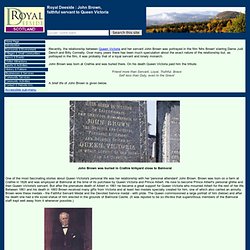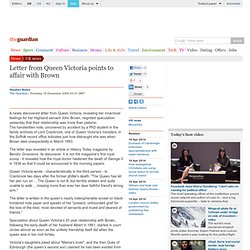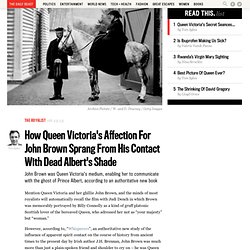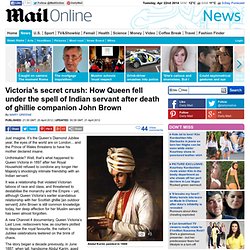

John Brown (servant) John Brown (8 December 1826 – 27 March 1883) was a Scottish personal servant and favourite of Queen Victoria for many years.

He was appreciated by many (including the Queen) for his competence and companionship, and resented by others for his influence and informal manner. The exact nature of his relationship with Victoria was the subject of great speculation by contemporaries, and continues to be controversial today. Brown was born in Crathie, Aberdeenshire, to John Brown and Margaret Leys, and went to work as an outdoor servant (in Scots ghillie or gillie) at Balmoral Castle, which Queen Victoria and Prince Albert leased in February 1848 and purchased outright in November 1851.
Brown had several younger brothers, three of whom also entered the royal service. Royal Deeside, Scotland : John Brown, servant to Queen Victoria. One of the most fascinating stories about Queen Victoria's personal life was her relationship with her 'personal attendant' John Brown.

Brown was born on a farm at Crathie in 1826 and was employed at Balmoral at the time of its purchase by Queen Victoria and Prince Albert. He rose to become Prince Albert's personal ghillie and then Queen Victoria's servant. But after the premature death of Albert in 1861 he became a great support for Queen Victoria who mourned Albert for the rest of her life. Between 1861 and his death in 1883 Brown received many gifts from Victoria and at least two medals specially created for him, one of which also carried an annuity. Brown wore these medals - the Faithful Servant Medal and the Devoted Service medal - with pride. Brown appears to have been very 'honest' in offering genuine friendship to the Queen at a time of need but equally telling unwanted truths to the important people surrounding her.
John Brown Statue, Balmoral Castle, Balmoral Estate, Crathie, Nr Ballater, Caingorms National Park, Aberdeenshire, Scotland, UK. Mrs. Brown. The film was produced by the BBC and Ecosse Films with the intention of being shown on BBC One and on WGBH's Masterpiece Theatre.

However, it was acquired by Miramax and released to unexpected success, going on to earn more than $13,000,000 worldwide. The film was screened in the Un Certain Regard section at the 1997 Cannes Film Festival.[1] Dench was nominated for the Academy Award for Best Actress, but lost to Helen Hunt for her role in As Good as It Gets. Plot[edit] As a result of Victoria's virtual recluse, especially at Balmoral Castle in Scotland (something initially encouraged by Brown), her popularity begins failing and republican sentiment begins growing. Prime Minister Benjamin Disraeli (Antony Sher) has a weakening hold over the House of Commons and a fear of rising anti-monarchical sentiment in the country. Brown is reluctant to do so, rightly fearing that Victoria will take this as a personal betrayal.
Brown continues to serve Queen Victoria until his death in 1883. Dr. Mrs Brown (1997. The Big Yin - Billy Connolly. Victoria's secret? According to tantalising new evidence, Queen Victoria married her Scottish groom and bore him a secret daughter who was spirited to America. By Michael Thornton Updated: 00:35 GMT, 25 February 2012 As the Queen advances indefatigably into the year-long festivities for her Diamond Jubilee, thoughts inevitably turn to the last British sovereign who survived to celebrate 60 years on the throne.

Queen Victoria’s Diamond Jubilee in 1897 marked the refulgent patriotic zenith of the British Empire. Standing less than 5ft tall, but nevertheless a towering colossus throughout the world, the iconic Queen Empress gave her name to an age that produced an empire measuring some 40 million square kilometres, with 387 million subjects. It was an age characterised by extreme sexual repression, strait-laced morality and invincible ignorance. Victoria flatly refused to allow her government to legislate against lesbianism, not because she approved of it, but because she regarded it as a physical impossibility. Close: Billy Connolly and Judi Dench in Mrs Brown. Runciman was a pre-eminent expert on the Crusades and the Byzantine Empire. Letter from Queen Victoria points to affair with Brown. A newly discovered letter from Queen Victoria, revealing her innermost feelings for her Highland servant John Brown, reignited speculation yesterday that their relationship was more than platonic.

The handwritten note, uncovered by accident by a PhD student in the family archives of Lord Cranbrook, one of Queen Victoria's ministers, in the Suffolk record office indicates just how distraught she was when Brown died unexpectedly in March 1883. The letter was revealed in an article in History Today magazine by Bendor Grosvenor, its discoverer. It is not the magazine's first royal scoop - it revealed how the royal doctor hastened the death of George V in 1936 so that it could be announced in the morning papers.
How John Brown Was Queen Victoria's Channel to Albert's Ghost. Ten years before the brutal genocide, a religious fervor gripped Kibeho as dozens claimed the Virgin Mary had appeared to them.

One of the chosen recalls her disturbing prophecy. Before Kibeho, a village spiraling up one of the area’s many hills, became a notorious killing ground during the Rwandan genocide, it was the country’s most celebrated holy spot. For nine years in the 1980s, it gained worldwide fame after a streak of schoolgirls claimed the Virgin Mary appeared to them with messages, including one that foreshadowed the country’s devastating genocide. The road south to Kibeho, paved until it slides into dirt for the last hour stretch from the capital of Kigali, is peppered with signs pointing to “Kibeho Holy Place.”
They lead through the sleepy town, where pairs of nuns can be spotted walking the streets in white-and-blue habits, to a stately brick church situated in a back clearing, crowning the village. Ruhinguka unlocks the memorial shed. But the visitors are still coming. Queen Victoria and Abdul Karim: After John Brown's death, Queen fell for Indian servant. By Mary Greene Published: 21:30 GMT, 20 April 2012 | Updated: 00:39 GMT, 21 April 2012 Abdul Karim painted in 1888 Just imagine.
